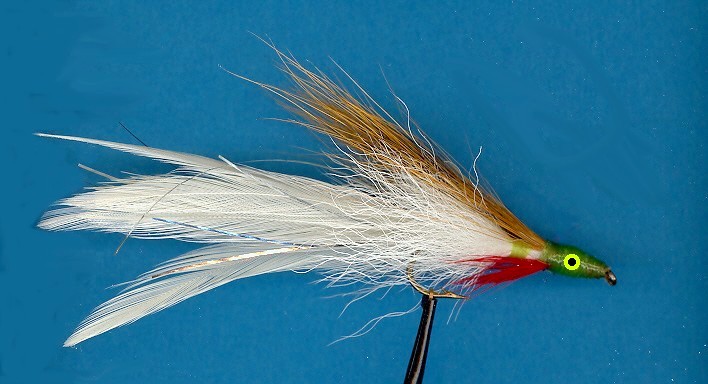On The Fly
"Fly tying is a school from which we never graduate"
 TYING NEWS
TYING NEWS
The Southern Oregon Fly Tiers held their monthly
meeting Wednesday, July 28th at the home of Johnny Hale in Central Point.
There were eight members who braved the heat and set up in Johnny's wood
shop. Not only did we get to tie on his custom-made hardwood benches but we
were treated to the best smoked salmon I've ever tasted, Some of us brought
fans and cold beverages. Dick Bonamarte showed how to tie the famous Zonker
and as usual he was in perfect form and up to the task. I showed how to tie
the Olive Partridge, featured in last month's newsletter. The members
donated another dozen steelhead flies to the auction, we had our fly
exchange, and Ron Rogers won the raffle. We discussed our meeting location
options with no final decision. Until a permanent solution can be found we
will notify the members of each month's location by phone or e-mail. If
anyone wants to get started tying or just wants help with a pattern or
technique, please accept our invitation to attend our informal group the
fourth Wednesday of each month at 7 p.m. If you have any questions, call Dan
Kellogg at 773- 4724.
 PATTERN OF THE MONTH - Baby Deceiver
PATTERN OF THE MONTH - Baby Deceiver
Hook: Size 4, 6 or 8 straight shank salmon.
Thread: White 6/0 for tail; green or olive for the collar and head.
Tail: Six white saddle hackles with 4-6 strands of silver flash each side.
Collar: White calf tail.
Topping: Squirrel tail.
Throat: Red hackle fibers.
Eyes: Stick-on or painted.
Tying Instructions:
1) Tie on in front and wrap thread base to the hook bend.
2) Strip saddle hackles to length; spoon two sets of three feathers together
and cement stems.
3) Tie on the two halves of the tail, one on each side of the hook shank,
with the cupped sides facing each other.
4) Attach 4-6 strands of silver flash on each side of the tail. The strands
should be different lengths and not reach end of tail.
5) Advance the thread towards the eye leaving room for the collar and head.
Coat the thread wraps with head cement.
6) Tie in a clump of calf tail on each side of the hook shank. The tips
should reach one-half shank length beyond the bend.
7) Tie in a slightly bigger bunch of darker squirrel tail on top of the
hook. Secure with several wraps and cement in place.
8) Tie in webby red hackle barbs on the bottom of the shank for the throat.
The tips should almost reach the hook point.
9) Build up a large enough head to accommodate the eyes. Attach or paint on
the eyes, white or yellow with black center. Model paint or nail polish
works great.
10) Give the head a coat of epoxy, several coats of nail polish, or try soft
body.
Most fly fishermen think of Lefty's Deceiver as the best-known, most-used saltwater fly. But change the hook size and the material slightly and you can tie the Baby Deceiver. It can be long and slender, short and stout, flashy and colorful, drab or subdued, as an imitation of a specific bait, or as a streamer like the fish have never seen. In the smaller hook sizes the proportions and 3-D shape do not change. It looks and acts like a minnow, and the little Deceiver will catch trout in still or moving water and during or in between hatches. Fly anglers always need a good sculpin pattern or a slinky, shaggy Wooly Bugger, but to represent most types of baitfish the Deceiver style works better than anything else. Because you can throw a size 4 with a fly rod, you can hunt big trout with light gear. For downsizing your Deceivers, you can use the slightly thinner-quilled saddle hackle or good quality hen-neck feathers. Instead of the traditional hackle tail, you can substitute marabou. It's easier to tie and has more wiggle, but hackle presents a cleaner silhouette. For the tail, try extra fine flash materials such as Polar Flash, Angel Hair, or Light Bright because their limpness works better on these shorter minnows. Don't overdress your Deceivers - use sparse clumps of hair. A lightly dressed fly sinks quicker and casts better. The uneven tips of the tail materials keep it from fouling on the cast and they create a fishy shape in the water, so don't stack the hair.
TYING TIPS - The Pill Box
I'm always looking for ways to save space and carry more
in my portable tying kit. I purchased several seven-day plastic pill
reminder boxes at my local pharmacy. Each compartment has its own lid
numbered I through 7. I find the compartments useful for storing hooks or
dubbing. In one box I have seven different sizes of dry fly hooks, in
another, seven different-sized nymph hooks and so on, you get the picture.
For dubbing I have drilled a 1/4 inch hole in each lid and store seven
different colors of my favorite dubbing. I get the dubbing started with my
tweezers and it just keeps coming with each pinch I take. The selection is
quick, the boxes are inexpensive and easy to mark, and they beat the heck
out of the little reclosable bags.
Tie One On,
Dan Kellogg
(you can contact me at FLYGUY@EZNORTHWEST.COM)